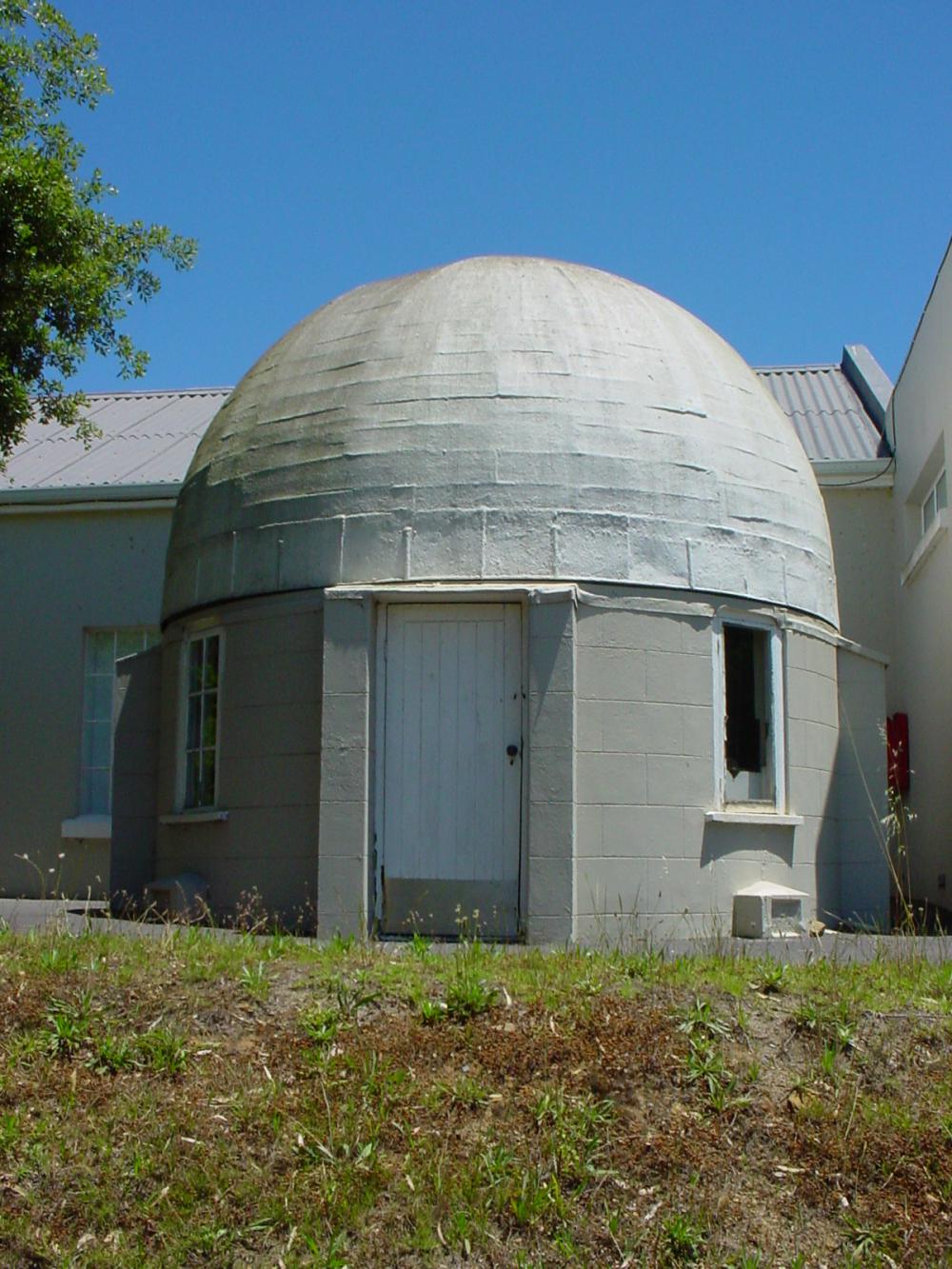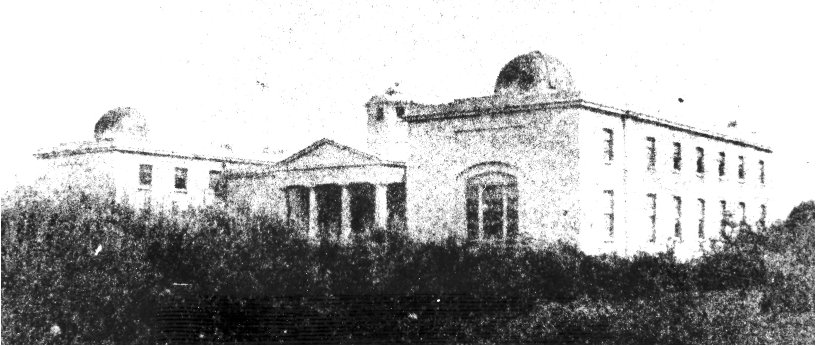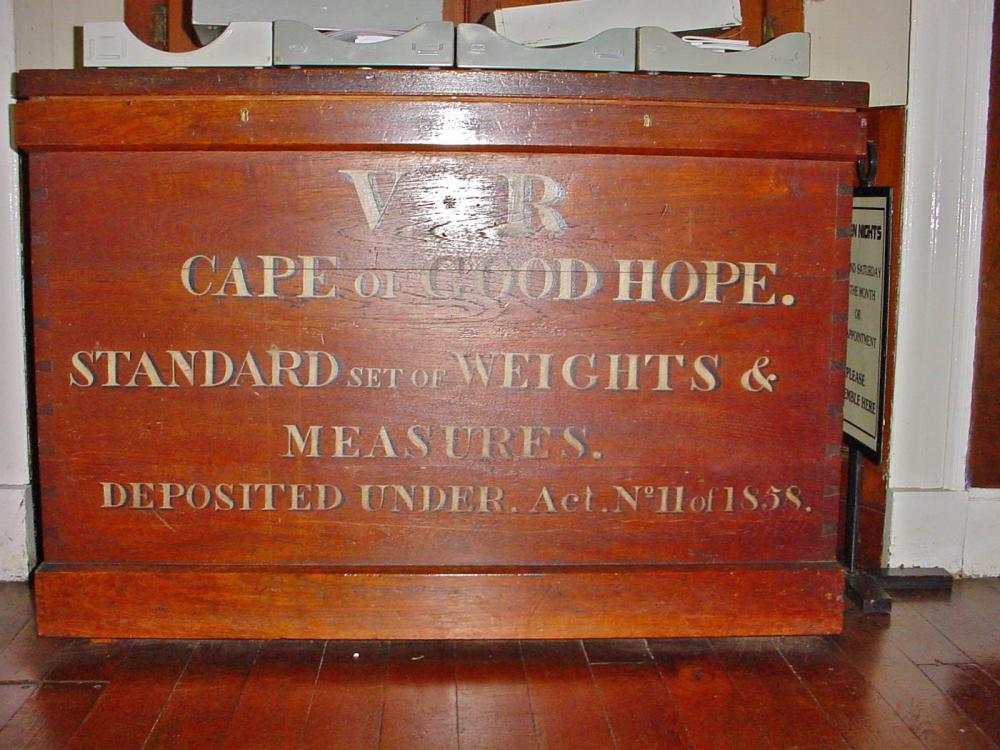
Category of Astronomical Heritage: tangible immovable
Royal Observatory, Cape of Good Hope, Republic of South Africa

Presentation
Geographical position
Observatory district, Cape Town, Western Cape Province, Republic of South Africa.
Location
Latitude 33° 56′ 3.5″ S, longitude 18° 28′ 39.0″ E. Elevation 15m above mean sea level. This is the location of the Airy Transit Circle.
General description
The Royal Observatory, Cape of Good Hope is the original name for the headquarters of the present-day South African Astronomical Observatory (SAAO). Its 9ha property occupies a small hill about 5km east of central Cape Town, within the Two Rivers Urban Park. Founded in 1820, the property remains in use for professional astronomy today. If an application in progress to the South African National Heritage Agency is approved, it will be the first South African cultural property designated for its scientific research history.

Brief inventory
The buildings on the site include:
- The Main Building of the Observatory, completed in 1828, a neo-classical structure designed by the naval architect John Rennie (1761-1821). It was built with walls of plastered-over uncut stone; teak floors, door, window frames and shutters; and impressive Doric pillars constructed of brick with wooden cladding.
- The Photoheliograph Building, completed in 1848, distinctive in having a pre-fabricated wooden dome that rotates on cannon balls.
- The McClean Building, completed in 1896. Designed by the famous architect Herbert Baker, this building combines elements of Dutch and British colonial architecture. It features a hydraulically operated rising floor. Originally, a hydraulic motor was also used to rotate the dome.
Many of the other buildings on the site have their origins in the nineteenth century.
The McClean Building still houses the McClean (or Victoria) telescope, manufactured by Howard Grubb of Dublin in 1897. Most of the other nineteenth-century telescopes are still in place including a photoheliograph similar to one designed by de la Rue (1878), a Grubb 6-inch telescope (1882), and a 13-inch Grubb Astrographic telescope (1889) used for the Carte du Ciel project. The Gill Transit Circle (1905) also remains in its original position, as does an 18-inch telescope manufactured by Cox, Hargreaves and Thompson in 1955.
The surviving moveable artefacts include a repeating transit used by the first astronomer before the completion of the Main Building; a speculum mirror by W Herschel (1811); a time signal pistol (1833); nine highly precise ‘regulator’ pendulum clocks; six chronometers by various nineteenth-century manufacturers; a Ross lens used by Sir David Gill for his epoch-making photography of the Great Comet of 1882; a large Dallmeyer portrait lens used for the Cape Photographic Durchmusterung (the first photographic sky survey); the eyepiece and lens of the Airy Transit Circle (installed in 1854); and a Victorian Standard Weights and Measures Box (the contents of which are said to be in a storeroom of the Iziko South African Museum in Cape Town).

History
The Royal Observatory was founded a few years after the Cape became a British colony, in order to determine accurate star positions and provide a reliable time service to aid maritime navigation. The chosen location was within clear view of the City’s harbour, Table Bay, so that visual time signals could be seen by visiting ships.
The Main Building, commenced in 1825 and completed in 1828, originally housed a mural circle and a transit telescope. By 1855, these had been replaced by a transit circle designed by Airy. Several other buildings and instruments were constructed in the nineteenth century, including a magnetic observatory (1841) comprising several buildings, none of which survives today.
During the regime of Sir David Gill, Her Majesty’s Astronomer during the years 1879–1907, activity on the site reached its zenith. This period saw the construction of the Astrographic dome (1888), the Heliometer dome (1888), the McClean dome (1896) and the Gill Transit Circle (1905).
The last instrument within the Main Building, the Airy Transit Circle, was removed in 1950. In 1972, the best telescopes were moved to Sutherland because the city’s skies had become too bright. However, the construction of new instruments continues to be carried out in the modern Technical Building, which accommodates special rooms and laboratories for numerically controlled machining, vacuum coating, metrology, electroplating etc.
Cultural and symbolic dimension
The Royal Observatory was the first major scientific institution to be erected on the continent of Africa. It is also the first permanent Observatory to have been constructed in the southern hemisphere. For much of the nineteenth century it occupied an important position in the Cape Colonial hierarchy, His or Her Majesty’s Astronomer being called upon to give advice and to serve on the boards of cultural and educational institutions.
Over the years, the Observatory became the repository of standard weights and measures as well as setting the standard of time. Its noonday cannon is still fired to this day. The centre of the Airy Transit Circle in the Main Building became the point of reference for all geographical positions in South Africa.
Several important scientific advances were made at the Observatory, including the first successful measurements of the distance of a star (Alpha Centauri, by Thomas Henderson in 1832-3); the first use of photography to make a systematic sky survey (by David Gill in 1885-90); and the determination (again by David Gill, in 1913) of the distance between the earth and the sun, the basic unit of length in solar system astronomy, regarded as the best available for some 45 years.
Authenticity and integrity

The present appearance of the site remains very much as it was left behind by Sir David Gill in 1907. Many of the buildings on the site are original structures, and the extant buildings still contain many of the instruments used over the Observatory’s history. The Main Building has been modified only marginally; the original teak floors, doors, window frames and shutters still remain. Most of the nineteenth-century telescopes are still in place and a number remain more or less in working order. The hydraulic rising floor mechanism of the McClean dome is still operational and makes use of its original 3-cylinder hydraulic pump. The McClean laboratory still exists, with its original cupboards, benches and fittings. Gill’s transit circle is also complete, as is the 18-inch telescope of 1955.
Nonetheless, the Royal Observatory, as a living institution, has evolved continuously since its foundation. Many buildings, fittings and instruments have come and gone, or been altered, to meet the changing requirements of science and to take advantage of advancing technology. Some of the old instruments have recently been restored.

Documentation and archives
All phases of the existence of the Royal Observatory are well documented. Large amounts of material exist in the following archives: the Hydrographic Office of the Royal Navy (UK); the Royal Greenwich Observatory Archives (now in Cambridge University Library); the South African Government Archives; and, of course, the SAAO Archives, which are kept on the Royal Observatory site. Rennie’s original designs for the Royal Observatory, dated 1 March 1821, are located today in the Public Record Office (UK).
Management and use
Present use
The property is owned at present by the National Research Foundation (NRF), the umbrella agency of which the SAAO and a number of other scientific institutes form part. The site is now the Headquarters of the Southern African Astronomical Observatory and the Southern African Large Telescope Foundation. It is used exclusively for astronomical purposes.
At the present time, the central part of the Main Building houses the National Library for Astronomy, one of the most comprehensive astronomical libraries in the world. The rooms in the wings, which were originally used as residences, are now mostly offices for the astronomers.
State of conservation
Most of the buildings are regularly maintained but some of those not in use for current astronomical projects require restoration. In particular, the Gill Reversible Transit Circle building of iron and steel is in poor condition. The archives and retired instruments are generally well protected from environmental damage.
Main threats or potential threats
The main threat to the Royal Observatory site lies in the ever-increasing pressure on open urban land from real-estate developers. Some degree of protection derives from the fact that the Royal Observatory is a limited-area site partly flanked by preserved wetlands that are unsuitable for development.
Protection
The property is central to the Two Rivers Urban Park, a conservation area established by the City of Cape Town. It is bordered to the East and North by wetlands. As such, it is protected from encroachment.
Context and environment
The site is no longer dark and rural. Beyond the boundaries of the Two Rivers Urban Park, it is surrounded by freeways, major roads, and office buildings. However, the property is one of the last remaining places close to the city centre where the original ecology of the area is preserved. The Two Rivers Urban Park is a wetland area that supports a wide range of bird and animal life as well as a variety of flowering bulbous plants. The Observatory marks the northern limit of the Western Leopard Toad (Bufo Pantherinus), an endangered species, and is the only remaining habitat of the rare iris Moraea Aristata. An ‘Observatory Baseline Information Study’ has been commissioned to further analyse the natural and urban environment of the site and better characterise its unique properties, with a view to preserving them.
Archaeological / historical / heritage research
The Royal Observatory is well documented historically in books by Sir David Gill and Brian Warner and by many articles in books and journals. There is ongoing historical research by various interested parties. An independent ‘Friends of the Observatory’ group was recently formed, aiming particularly to restore the old instruments and domes to working order.
Management, interpretation and outreach
The McClean telescope is used on open nights for public viewing and, very occasionally, for special occultation events, while the adjoining astrophysical laboratory is preserved as a museum. It also contains a selection of the smaller antique instruments no longer in use.
For many decades there has been a public outreach programme. Open nights are held at least once a month, when members of the public are given free of charge a tour of the Observatory, a lecture on an astronomical topic and the opportunity to view the sky through a telescope. In addition, many school and other groups tour the establishment during the daytime.
References
Bibliography (books and published articles)
- Forbes, G. (1916). David Gill, Man and Astronomer. London: John Murray.
- Gill, David (1913). History and Description of the Royal Observatory, Cape of Good Hope. London: HMSO.
- Glass, I.S. (2008). Proxima, the Nearest Star (Other than the Sun). Cape Town: Mons Mensa.
- Laing, J.D. (1970). The Royal Observatory at the Cape of Good Hope 1820-1970: A Sesquicentennial Offering. Cape Town: Royal Observatory.
- Moore, P. and Collins, P. (1977). The Astronomy of Southern Africa. London: Robert Hale.
- Warner, Brian (1979). Astronomers at the Royal Observatory, Cape of Good Hope. Cape Town and Rotterdam: Balkema.
- Warner, Brian (1983). Charles Piazzi Smyth, Astronomer-Artist. His Cape Years 1835-1845. Cape Town and Rotterdam: Balkema.
No multimedia content published
Currently there is no multimedia content published for this case study





















